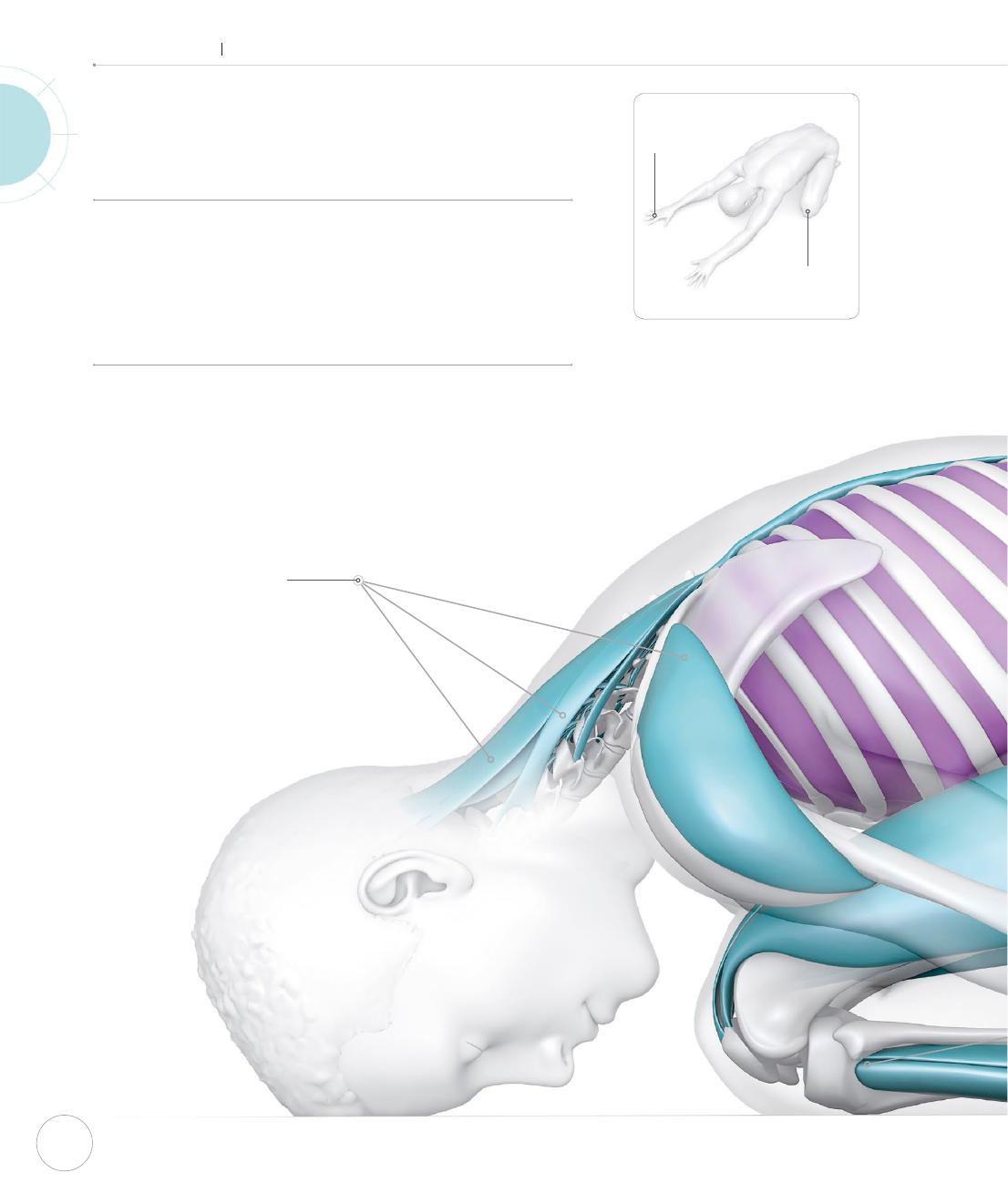
72
THE ASANAS
Seated
Reminiscent of the fetal position and with your weight
supported by the oor, the restorative forward bend of
Child’s pose can be a deeply relaxing, restful posture
for many. It provides a deep but gentle stretch for your
back muscles, calming both body and mind.
THE BIG PICTURE
With as little muscle engagement as possible, your body
releases down. In particular your back muscles, buttocks,
and ankles stretch out. As you breathe deeply, the muscles
in and around your ribcage dynamically engage and
stretch with each breath.
CHILD’S POSE
Balasana
Neck and upper arms
Your neck muscles are passive
with your splenius capitis and
splenius cervicis stretching.
Your posterior deltoids slightly
stretch while your shoulders are
in internal rotation. Your arm
muscles are passive with your
forearms pronated, allowing
the backs of your hands to
rest on the oor.
VARIATION
Another option is to separate
your knees and bring your hands
forward. This allows more space
for the torso and is a common
resting pose during sequences
such as sun salutations.
Knees open
to create space
Hands reach
forward
Splenius cervicis
Splenius capitis
Deltoids
US_072-073_Child_pose_01.indd 72 02/11/2018 14:02

73
Torso
With your spine in slight exion,
your spinal extensors stretch. In
particular, when you inhale and
exhale deeply with awareness,
the small, deep muscles along
your spine stretch gently.
ALIGNMENT
Your abdomen is compressed as you release
your body weight down. Drop your head,
allowing your forehead to rest on the floor or
use a bolster or blankets for support.
Knees are
close together
Arms released
at sides
Ankles
together
Forehead rests
on floor
Front of
shoulders drop
forward
Thighs and lower legs
Your quadriceps and gluteus
maximus stretch while you
try to release all the muscles
around the thighs. Your
dorsiexors may be stretching
while your feet rest in plantar exion.
KEY
Joints
Muscles
Engaging while
stretching
Stretching
Gluteus maximus
Tibialis anterior
Extensor hallucis longus
Extensor digitorum longus
Rectus femoris
Vastus lateralis
Quadratus lumborum
Spinal extensors
Spine
Intercostal muscles
US_072-073_Child_pose_01.indd 73 20/09/2018 20:46

74
CHILD’S POSE
Balasana
CLOSER LOOK
Child’s pose can be an opportunity to rest, take deep
breaths, relax tired muscles, and access a primal sense
of safety. If comfortable, you can use this pose as a place
of rest and rejuvenation between challenging poses.
Intercostal muscles
Your intercostals are crisscrossed
and layered, like your abdominals.
Your external intercostals engage
to help you inhale. Your internal
intercostals engage to help you
forcefully exhale. Your innermost
intercostals stabilize your ribs,
stretching when you inhale. Feel
how dynamic your rib movement
is while you take deep breaths here.
Head rest
Throughout the day, your neck muscles have
the job of holding up the 11lb (5kg) bowling ball
that is your head. This muscular activity keeps
your nervous system on slight alert. Letting
the muscles of your neck and head
completely relax lets your nervous
system know it is safe to rest.
Neck muscles are
completely relaxed
External intercostals
Rib
Blood vessels
Nerve
Internal
intercostals
Innermost
intercostals
If needed, put a block
or cushion beneath
your forehead
Splenius muscles
SUPERIOR–LATERAL VIEW
Quadriceps
stretch
US_074-075_Child_pose_02.indd 74 02/11/2018 14:02

75
THE ASANAS
Seated
Pressure points
Allow your body to release down completely,
with your shins, feet, forearms, hands, and
forehead all resting on the ground. If your
body doesn’t make this shape, use
blankets and props to nd support.
Intercostal muscles
dynamically stretch
and engage with
deep breaths
Shoulders
drop forward
Shins rest
on the
ground
Ribcage
expands in
all directions
A blanket under
the ankles can
relieve pressure
for some
Spinal extensors
stretch while in
relaxed flexion
Gluteal muscles
stretch
POSTERIOR VIEW
Fetal position
This pose may evoke comfort
as it is reminiscent of being in
your mother’s womb. In the
fetal position, most of your
joints are in exion, protecting
your abdominal organs from
harm. Notice how your body
moves with each breath: your
torso rising and broadening
with each inhale and releasing
back as you exhale.
Arms are relaxed
and rest down at
your sides
US_074-075_Child_pose_02.indd 75 25/09/2018 17:03
..................Content has been hidden....................
You can't read the all page of ebook, please click here login for view all page.
